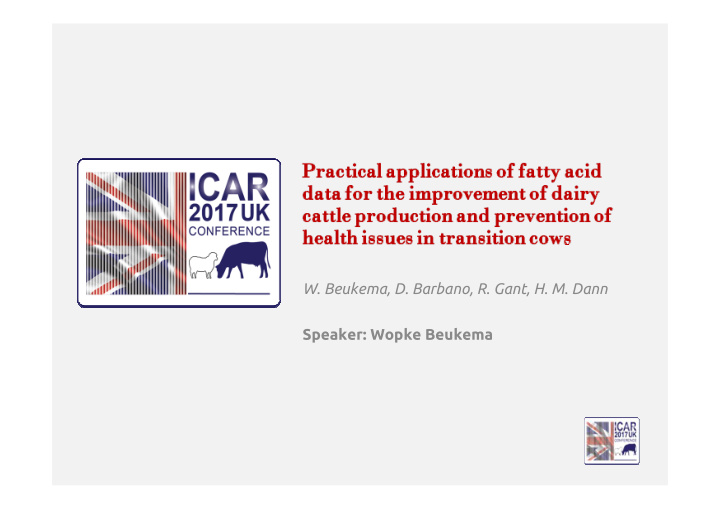



W. Beukema, D. Barbano, R. Gant, H. M. Dann Speaker: Wopke Beukema
Practical applications of fatty acid data for the improvement of dairy cattle production and prevention of health issues in transition cows by Wopke Beukema Delta Instruments and Perten Instruments
Delta Instruments is a well-established manufacturer of rapid routine analytical instrumentation for the analysis of raw milk and its derivatives. Perten Instruments is a leading supplier of analytical instruments for the food industry, offering a wide range of analytical methods for dairy products and processing. Delta is now part of Perten and together we offer the widest range of analytical instruments for dairy analysis.
Herd Management Tools In 2014 we reported a positive correlation between the de novo fatty acids and total production, total milk fat test, and true protein output in bulk tank milk .
Herd Management Tools for bulk tank milk By improving cow comfort levels and feeding management, total production, milk fat test and true protein output in bulk tank milk can be improved. Factors affecting digestion of forage in the rumen drive de novo and mixed origins FA synthesis in the udder. Preformed FA come from the mobilization of body fat (especially in early transition) and fat in the consumed feed.
Field observations for Holstein farms For a Holstein bulk tank milk fat test > 3.75%, the de novo FA level must be > 0.85 g/100g milk
Field observations for Holstein farms … and the mixed origins FA level must be > 1.4 g/100g milk
Field observations for Holstein farms In addition: A de novo FA level > 0.85 g/100g milk might also result in higher bulk tank milk protein level > 3.10 g/100g milk.
Field observations for Holstein farms NEW! For a Holstein bulk tank milk fat test of > 3.75% and protein test > 3.10%, the double bonds per fatty acids needs to be ≤ 0.31.
Fitting MUN with the FA data MUN reflects the efficiency of the use of nitrogen sources in the rumen If MUN is too high it is an indication that nitrogen (dietary protein ) may be higher than needed. Variations provide information related to access to feed : When cows have no access to feed, MUN will decrease rapidly : Cows that lack access to feed for 5 hours in the night will cause the bulk tank MUN to decrease from 13 to 9 (mg/dl), while milk fat decreases about 0.5% g/100g milk (from lower de novo and mixed origins FA) . Prolonged low access to feed results in slug feeding and a daily cycling of pH, resulting in lower fat and protein test from a lower conversion efficiency of feed to milk.
Importance of energy density in the ratios When the energy density of the rations decreases, it shifts the cows in the direction of negative energy balance: • Initially, the mixed origins FA will decrease in the milk, cows start losing weight because they are mobilizing body fat, causing the preformed FA to increase. • When prolonged, cows continue to mobilize body fat, they lose body condition, and ultimately all three fatty acids will decrease along with fat and protein content of milk, and pounds of milk per day.
Field examples of Holstein farms Values of a healthy Holstein herd • Producing: 92 ponds of milk per day. • Fat: 3.89% de novo: 0.87 g/100g milk • mixed origins: 1.41 g/100g milk • Interpretation: preformed: 1.46 g/100g milk • • Protein: 3.13% This herd is doing well. • Lactose: 4.59% • Double bonds per FA: 0.279 • MUN: 10.9 mg/dl • SCC: 160.000 cells/ml
Field examples of Holstein farms Values of a Holstein herd with milk fat depression • Producing: 91 ponds of milk per day. • Fat: 3.46% Interpretation: de novo: 0.72 g/100g milk • This herd has milk fat depression, but mixed origins: 1.2 g/100g milk • the volume of milk is good and the preformed: 1.31 g/100g milk • protein is holding. • Protein: 3.10% • Lactose: 4.61% This herd appears to have a trans fatty acid induced milk fat depression • Double bonds per FA: 0.342 from an excessive availability (level • MUN: 11.2 mg/dl and rate of release) of unsaturated • SCC: 200.000 cells/ml fatty acids in the rumen
Field examples of Holstein farms Values of a Holstein herd with multiple problems • Producing: 79 ponds of milk per day. Interpretation: • Fat: 3.09% The high double bonds per FA and low de novo and mixed FA indicate de novo: 0.65 g/100g milk • that the milk fat depression is due to mixed origins: 1.08 g/100g milk • release of too much unsaturated fat preformed: 1.16 g/100g milk • in the rumen. • Protein: 2.88% The low volume of milk appears to be related to lower lactose production • Lactose: 4.53% (gr/day). • Double bonds per FA: 0.340 The herd average body condition • MUN: 8.9 mg/dl score was confirmed to be low, which • SCC: 160.000 cells/ml is consistent with low preformed FA in milk.
Herd Management Tools in transition cows • Information about evolution of de novo FA provide an early warnings on displaced abomasum • The milk predicted blood NEFA provide information about the severity of the energy balance status, and early warnings on clinical and subclinical ketosis.
Field examples of individual cow Cow with high body condition at calving with good liver function
Field examples of individual cow Cow with a displaced abomasum
Field examples of individual cow Cow with ketosis
Thank you for your attention! Questions?
Recommend
More recommend